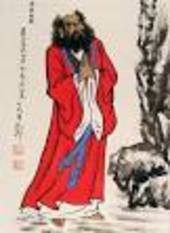Since Tenshin Reb Anderson’s inspiring talks in his 2014 retreat in Fyllingbo, Sweden concerning our fourth Chinese ancestor Dayi Daoxin I have read more widely and researched the lives and legends of these earliest zen masters. I have been intrigued and fascinated by their practice and fortitude, their insight and compassion, as well as their eccentricity and humour, especially their humour!
This article, the first of a series, is my attempt to remind readers of Mountain Silence of the debt that we owe to these men and women, not unlike us, who often devoted themselves to practice under very difficult circumstances. As with any good story we should begin at the beginning or, rather near the beginning. When Bodhidharma in the 5th century C.E. set off from India to take, at his teacher’s Prajnadhara’s behest, Mayahana teachings to China, Buddhism had already been established there since the 1st C.E. The perilous journey took three years travelling through the Straits of Malacca to Guangzhou in Southern China. Bodhidharma remained here for some time, possibly acquainting himself with the language, before travelling north where the legend of his meeting with Emperor Liang Wudi (Wu) has become the supreme example of ‘pointing at the mind to reveal Buddha nature’.
The Emperor had attained power through assassination and intrigue but, perhaps in an attempt to atone for these acts, became a great supporter of Buddhism. He therefore asked Bodhidharma what merit he would attain from such acts. The sage’s answer was uncompromising ‘No merit.’
I imagine Emperor Wu was somewhat taken aback by this, but to give him credit, he attempted to save face by asking Bodhidharma to explain the highest truth of Buddhism. Again the answer was koan like and enigmatic, ‘Emptiness nothing holy.’
By now the Emperor must have felt the rug being pulled from under his feet and in desperation queried ‘Who is it that faces me.’
The sage’s answer was again shocking and apparently senseless.
‘I don’t know.’
The Emperor was totally bemused but according to some stories intuited that he had had a life changing opportunity and missed it and wanted to send a messenger to call back Bodhidharma who had set off north. His vizier however realising that there was no way that such a master could be persuaded changed Wu’s mind.
On Mt. Song at the Shaolin monastery Bodhidharma spent nine years ‘facing a wall’. It is said that at the end of this extended sessin the sage wished to return to India but other accounts say he was poisoned by jealous rivals but was then encountered by a monk three years later wandering in the Himalayas carrying one sandal. When this story reached the new Emperor he had Bodhidharma’s grave opened only to find it empty except for one sandal!
Scholars agree that a text known as ‘Outline of Practice,’ was probably written by Bodhidharma.
Next time: The Second patriarch Dazu Huike 487-593 C.E.
Much of the information in this article is based on the detailed account in ‘Zen’s Chinese Heritage.’ by Andy Ferguson published by Wisdom Books 2000 and several Wikkipedia articles.
Back to front page
